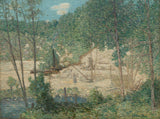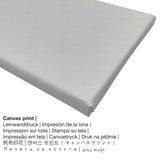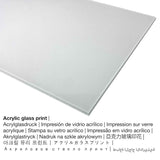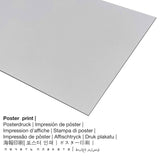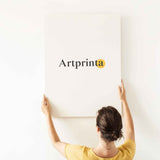J.Alden Weir, 1908 - La construction du barrage - tirage d'art
TTC Expédition calculée à la caisse.
Les détails du produit d'art
Le chef-d'œuvre The Building of the Dam a été créé par J. Alden Weir in 1908. The version of the artwork was painted with the size of Framed: 93,5 x 118,5 x 7,5 cm (36 13/16 x 46 5/8 x 2 15/16 in); Unframed: 76 x 101,6 cm (29 15/16 x 40 in) and was made with the technique of huile sur toile. Le chef-d'œuvre a le texte suivant comme inscription: signed lower right: "J. Alden Weir". Cette œuvre d'art peut être vue dans la collection de Le musée d'art de Cleveland. We are glad to reference that this masterpiece, which is part of the public domain is included with courtesy of Le musée d'art de Cleveland. : Purchase from the J. H. Wade Fund. Furthermore, alignment of the digital reproduction is paysage et a un ratio de 4: 3, ce qui signifie que la longueur est 33% plus longue que la largeur.
Matériaux de produits disponibles
Nous proposons une gamme de matériaux et de tailles différents pour chaque produit. C'est pourquoi, nous vous permettons de choisir parmi les options suivantes:
- L'impression sur verre acrylique: A glossy print on acrylic glass, often referred to as a fine art print on plexiglass, will transform your favorite original into marvellous home decoration. Your work of art will be made with the help of state-of-the-art UV direct print technology. The major benefit of a plexiglass print is that sharp contrasts and minor details will be visible with the help of the delicate gradation.
- Poster (matériau en toile): The poster is a printed sheet of cotton canvas with a granular texture on the surface. The poster print is suited for framing the art replica in a custom frame. Please keep in mind, that depending on the size of the poster print we add a white margin of something between 2-6 cm round about the print, which facilitates the framing with a custom frame.
- Tirage aluminium (aluminium dibond): An Aluminium Dibond print is a print with an impressive depth effect. The bright and white parts of the original work of art shine with a silky gloss but without any glow. Colors are vivid and luminous, the fine details appear crisp, and you can notice a matte appearance of the fine art print.
- L'impression sur toile: A printed canvas, which should not be mistaken with a real artwork painted on a canvas, is a digital copy printed from a UV direct printing machine. Hanging your canvas print: Canvas prints are relatively low in weight, meaning that it is easy to hang up your Canvas print without extra wall-mounts. Canvas prints are suitable for any type of wall.
Note légale importante: We try everything to describe our products with as many details as possible and to demonstrate them visually in our shop. Nonetheless, the pigments of the printing material, as well as the imprint might vary marginally from the representation on the device's screen. Depending on the screen settings and the nature of the surface, color pigments might not be printed as realistically as the digital version depicted here. Given that all our are printed and processed manually, there might as well be slight discrepancies in the motif's exact position and the size.
Les spécifications du produit
| Classification du produit: | copie d'art |
| La reproduction: | reproduction numérique |
| Méthode de production: | Impression UV / impression numérique |
| Fabrication: | fabriqué en Allemagne |
| Type de stock: | production à la demande |
| Utilisation proposée du produit: | art mural, collection d'art (reproductions) |
| Orientation: | alignement du paysage |
| Rapport d'aspect de l'image: | longueur en largeur 4: 3 |
| Implication du rapport latéral: | la longueur est 33% plus longue que la largeur |
| Matériaux disponibles: | impression d'affiche (papier de toile), impression sur verre acrylique (avec revêtement en verre véritable), impression sur toile, impression métallique (aluminium dibond) |
| Variantes sur toile (toile sur châssis de civière): | 40x30cm - 16x12 ", 80x60cm - 31x24", 120x90cm - 47x35 ", 160x120cm - 63x47" |
| Impression sur verre acrylique (avec revêtement en verre véritable): | 40x30cm - 16x12 ", 80x60cm - 31x24", 120x90cm - 47x35 " |
| Tailles d'impression d'affiche (papier de toile): | 40x30cm - 16x12 ", 80x60cm - 31x24", 120x90cm - 47x35 " |
| Tailles d'impression dibond en aluminium (matériau en aluminium): | 40x30cm - 16x12 ", 80x60cm - 31x24", 120x90cm - 47x35 " |
| Encadrement impression d'art: | pas disponible |
Informations générales sur l'oeuvre
| Titre de l'œuvre: | "The Building of the Dam" |
| Classification: | peinture |
| Classification artistique: | l'art moderne |
| Classification temporelle: | 20th siècle |
| Année: | 1908 |
| Âge de l'oeuvre: | plus de 110 ans |
| Support d'origine: | huile sur toile |
| Taille originale de l'oeuvre: | Encadré: 93,5 x 118,5 x 7,5 cm (36 13/16 x 46 5/8 x 2 15/16 in); Sans cadre: 76 x 101,6 cm (29 15/16 x 40 po) |
| Inscription de l'oeuvre originale: | signed lower right: "J. Alden Weir" |
| Musée / emplacement: | Le musée d'art de Cleveland |
| Lieu du musée: | Cleveland, Ohio, États-Unis d'Amérique |
| Page Web du musée: | Le musée d'art de Cleveland |
| Licence d'illustration: | domaine public |
| Avec l'aimable autorisation de: | Le musée d'art de Cleveland |
| Ligne de crédit de l'oeuvre: | Achat auprès du Fonds JH Wade |
Tableau récapitulatif des artistes
| Nom d'artiste: | J. Alden Weir |
| Nationalité de l'artiste: | Américaine |
| Travaux: | peintre |
| Pays d'origine: | États-Unis |
| Classification: | artiste moderne |
| Vie: | 67 ans |
| Année de naissance: | 1852 |
| Année de mort: | 1919 |
© Droits d'auteur | Artprinta (www.artprinta.com)
Spécifications supplémentaires par le site Web du musée (© Copyright - par le Cleveland Museum of Art - Le musée d'art de Cleveland)
This painting shows the construction of the Scotland Dam, built between 1907 and 1909 on the Shetucket River near the artist's home in Windham, Connecticut. Unlike painters from the Ash Can School, such as John Sloan and George Bellows who tended to portray more sordid views of urban life, Weir hid a potentially ugly industrial scene behind trees and foliage. He used a silver palette with pastel blues and greens to mask the construction equipment behind a veil of natural beauty. Early in his career, Weir was interested in drawing and design and used a conservatively dark palette. Under the influence of his friends Albert Pinkham Ryder, John Henry Twachtman, and Theodore Robinson, the artist's palette lightened in the late 1880s, and by the 1890s he had developed his Impressionist style.

